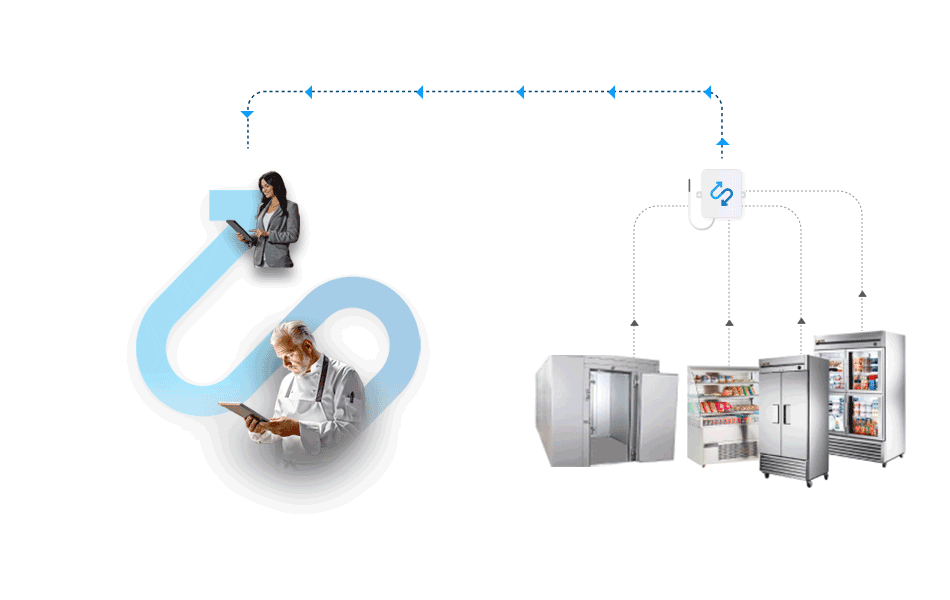How to prevent temperature logging violations
Temperature logging violations are a common problem in the food service industry. Staff members may forget to measure or measure temperatures incorrectly, which can lead to violations. Manual temperature logging is also error-prone. Improper management of food temperature can lead to food inventory losses and equipment downtime losses. Failure to immediately notice an equipment failure can slow service time and limit what menu items will be available to customers. Not having sufficient data to make operational decisions, such as whether to replace or repair assets, can also be problematic.
In this blog post, we will discuss some tips on how food service operations can prevent temperature logging violations and ensure that food products are stored and handled safely.
Use automated temperature monitoring systems
One of the best ways to prevent temperature logging violations is to use automated temperature monitoring systems. These systems use wireless sensors and remote monitoring software to automate equipment temperature monitoring. This removes the need for staff members to manually measure temperatures, reducing the risk of errors and violations.
Automated temperature monitoring systems provide real-time notifications when temperatures fall out of the operating range. This allows food service operations teams to take immediate action to address any issues and prevent food spoilage.
Implement standard operating procedures
Standard operating procedures (SOPs) are essential for preventing temperature logging violations. SOPs should outline the process for measuring and recording temperatures, as well as the protocol for addressing any issues that arise. Staff members should be trained on these procedures and be required to follow them consistently.
SOPs should also include guidelines on equipment maintenance and calibration. Properly calibrated equipment ensures accurate temperature readings, reducing the risk of violations.
Conduct regular audits and training
Regular audits can help identify any issues with temperature monitoring and ensure that staff members are following SOPs. Audits should include a review of temperature logs and equipment maintenance records.
Training is also essential for preventing temperature logging violations. Staff members should be trained on the importance of temperature monitoring and the proper procedures for measuring and recording temperatures. Regular training sessions can help reinforce best practices and ensure that staff members are up-to-date on any changes to SOPs.
How Stratosfy’s Deskless Operations Platform can help
Stratosfy’s Deskless Operations Platform provides an effective solution to temperature logging violations by automating temperature monitoring, ensuring that the optimal temperature range is maintained, and catching equipment failures early. The platform uses wireless sensors and remote monitoring software to automate equipment temperature monitoring, eliminating the need for staff members to manually measure temperatures.
The platform provides real-time notifications when temperatures fall out of the operating range. This allows food service operations teams to take immediate action to address any issues and prevent food spoilage. The platform also provides a comprehensive set of reports to cover all facets of your operation, including temperature reports and incident reports.
Stratosfy’s Deskless Operations Platform also enables teams to keep an eye on equipment anomalies and corresponding repair costs, verify, analyze, compare, and share repair cost information of every piece of equipment to keep track of expenses, and make better fix-or-buy decisions. By using this platform, food service operations teams can improve their operational efficiency, reduce food temperature management losses, and safeguard the quality, freshness, and safety of their food products.
Conclusion
Temperature logging violations can have serious consequences for food service operations. Implementing automated temperature monitoring systems, standard operating procedures, regular audits, and training can help prevent violations and ensure that food products are stored and handled safely. Stratosfy’s Deskless Operations Platform provides an effective solution to these problems by automating temperature monitoring, ensuring that the optimal temperature range is maintained, and catching equipment failures early. By using this platform, food service operations teams can improve their operational efficiency, reduce food temperature management losses, and safeguard the quality, freshness, and safety of their food products.









